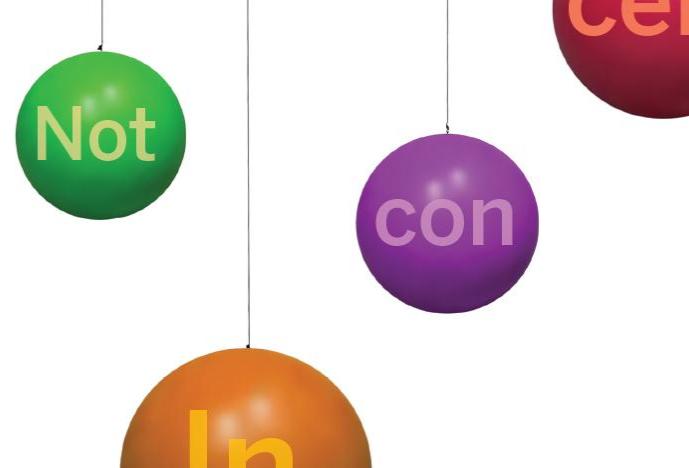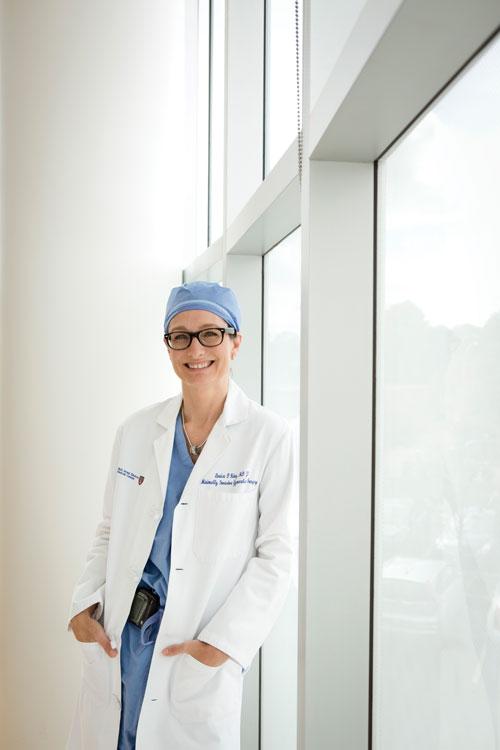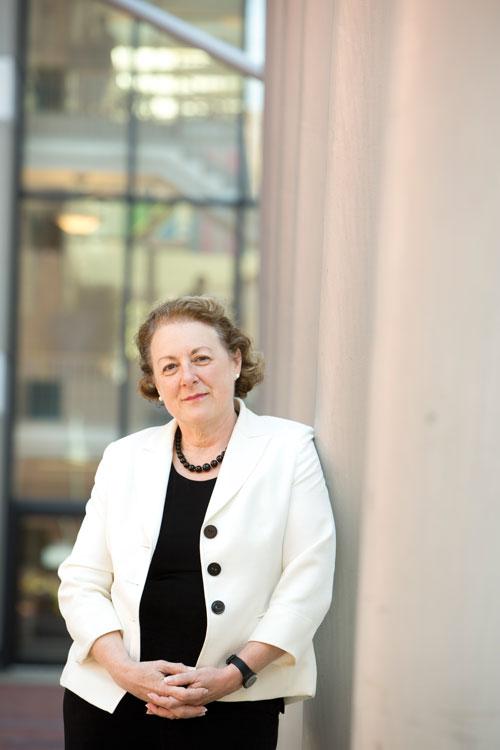Not Inconceivable
Amid a growing range of reproductive technologies, ethicists confront questions arising from access and application
- Feature

Louise King shakes her head as she considers her title at the HMS Center for Bioethics: director of reproductive ethics. Who, she asks, could presume to direct such a multidimensional field?

A recent morning at Beth Israel Deaconess Medical Center offers a glimpse into one of the field’s dimensions as King, who also is an HMS assistant professor of obstetrics, gynecology, and reproductive biology at Beth Israel Deaconess, makes her way to an ethics committee discussion about a particular couple’s request. As the parents of a seriously ill child, the couple hoped for assistance in selecting an embryo that would become the best match for their child, who, barring a bone marrow transplant from a compatible donor, had a poor prognosis. In short, they wanted help conceiving a “savior sibling.”
The technology that could help them is one of several collectively referred to as assisted reproductive technologies, ART for short. And while ART can make babies, it cannot say who should have them.
Neither can ethics committees, which helps explain King’s wonderment at all that her title represents. Bioethicists and clinicians like King and her colleagues see themselves as educators, explaining the medical consequences of certain decisions and providing a prism through which these learners and teachers try to refract the future.
Room for More
Perhaps the most recognized ART procedure is in vitro fertilization, or IVF, but technologies such as cryopreservation and preimplantation genetic diagnosis are also available. In general, these technologies are used to assist human reproduction in individuals who, for one reason or another, have not been able to conceive by other means, including other medical and surgical options. It’s not without failure, but ART can help the 15 to 20 percent of heterosexual couples who are infertile achieve a viable pregnancy.
The range of available technologies also means that more people can now become parents. IVF, for example, can help gay or transgender couples have children: Egg and sperm can be combined in a lab dish and implanted later in one parent or in a gestational surrogate.
Cryopreservation, another type of ART, can preserve fertility for cancer patients or for people not yet ready to start a pregnancy. Preimplantation genetic diagnosis can be used to diagnose disorders in embryos or predict the risk of disease in adulthood, while embryo selection technology can allow parents to choose one embryo over another. The latter is employed in savior sibling situations.
Balancing Act
Ever since Louise Joy Brown came into the world on July 25, 1978, bringing with her the term “test-tube baby,” people have been troubled by the role of technology in reproduction. Members of the clergy, for instance, have been concerned about humans playing God, and, together with nonclerics, have feared—and still fear—the use of these new tools to create so-called designer babies.
As the number of children born using ART grew, however, so did demand for the technologies. Swelling demand brought waves of ethical questions, each one incrementally advancing the discussion.
One example of such an advance involved parenthood for gay couples. Thirty years ago, hospital committees debated whether to help gay couples have children. Such a case would not reach an ethics committee today, as both social norms and clinical policies have evolved.
Savior siblings, too, have gained in acceptance. Fears for the child conceived as a donor have been allayed as families with such siblings have found the experience to be beneficial.
Cases that do get a hearing by committee or a consultation with a bioethicist are sometimes brought up for discussion by clinicians who want to explore their own discomfort with going forward. King calls it the “ick” factor in ethics: What makes you uneasy demands to be examined.
Once providers enter the equation, they become moral agents, bringing their own principles and beliefs into the picture. Should they implant an embryo with a risk of disability when patients and clinicians disagree on what defines disability? What about gender selection?
Some ethicists say one could argue there is no more reason to question the suitability of a parent when ART is involved than to evaluate it when people have children the “natural” way. If parents considering a sibling for a sick child in need of a transplant would have had a child anyway, what is the harm in using ART to select the best match?

In weighing such questions, bioethicists lean on four pillars: autonomy, justice, beneficence, and nonmaleficence. These terms frame as essential the right to choose, the importance of treating all people fairly, the hope of doing good, and the prevention of doing harm.
“There are balances in every choice we make, and the enhancement of a patient’s autonomy is done by affording them a full understanding of everything that’s being offered to them,” King says. “I’m not an arbitrator. I’m mediating a discussion so that everybody can exercise their own autonomy.”
The Rights Direction
Future children factor into the discussions as well. In the savior sibling scenario, King worries about expectations placed on the child conceived as a donor. Children also sit squarely in debates over what constitutes a disability or a disorder. Is deafness a disability? Is small stature?
Ethical principles do not mandate which people have a right to become parents, but the American Society for Reproductive Medicine does, or at least comes very close to doing so. An opinion piece on disparities in access to effective infertility treatments, published in November 2015 in Fertility and Sterility, one of the society’s publications, states, “Creation of a family is a basic human right.”
Rosemary Reiss, an HMS assistant professor of obstetrics, gynecology, and reproductive biology at Brigham and Women’s Hospital, thinks creating a family is not a right in itself. Instead, she thinks that although people have a right to try to conceive, there can be no guarantee of a successful pregnancy. Society must protect everyone’s right to choose to become parents; for example, the state or the medical community cannot force sterilization. But, she adds, this does not necessarily lead to the conclusion that society is obligated to devote unlimited resources to assisting infertile couples. She points out a distinction between the right to bear a child and the right to education for a child: In our society, the right to an education means there are laws that compel governments to provide education and that require parents to ensure their children receive that education.
“People may have a right to try to bear children,” says Reiss. “The availability of ART poses the question of whether everyone has a right to medical interventions to increase their chances of success at conceiving. And, if they do, which interventions?”
Public Constraints
In 2013, nearly 68,000 babies were born in the United States as a result of ART. Yet there is little regulation of the technologies in this nation compared to other countries, particularly those with national health services.

“It’s pretty much the Wild West here, with unregulated opportunities to shop for someone who will help you become a parent,” says Christine Mitchell, executive director of the HMS Center for Bioethics and a lecturer on global health and social medicine.
In such a market economy, insurance coverage depends on the state in which you live. In 2015, one cycle of in vitro fertilization, including medications, had a median price tag of $19,200. But only fifteen of fifty states mandate coverage for fertility care. Private insurance companies and Medicaid—and, of course, independent personal means—have become the arbiters of who can avail themselves of ART.
Ways of working within the narrow confines of coverage have led to such measures as double implantation. If a woman has exhausted coverage for cycles of egg implantation, she may ask a doctor to implant two embryos to increase her chances of giving birth to one child. In Japan and the United Kingdom, only single-embryo implantation is allowed, a response to data showing poor outcomes for both mother and children as a result of pregnancies leading to multiple births.
The question of who has access to ART can arise far earlier in the process. Economic and social restrictions on ART can taunt those surrounded by a culture that says, in essence, “Go for it.”
Yet, says King, if you look at who most often has access to IVF, “it’s not simply people who are well-off and white. It’s people who are well educated and understand what to seek out.”
King thinks access to ART should be expanded, not only by increasing funding for ART services, but also by better educating primary care providers about infertility, its causes, and the importance of teaching young women from all walks of life about those causes.
“It is our duty as reproductive physicians and surgeons to ensure educational opportunities for our patients, regardless of their socioeconomic status,” she says.
Facing the Unknown
Educating people to the possibilities of assisted reproduction also means educating them to the risks.
No one likes to dash hopes when genetic test results reveal potential problems, says Reiss. No one likes to say no.
“You’d like to make it possible, so you say, here are the risks. Many disorders have a spectrum of severity and not all tests are as accurate as one might hope.”
Preimplantation genetic tests now look for hundreds of abnormalities, rather than just a handful of well-known conditions, such as Down syndrome. Predicting the severity of a disorder can be challenging, and the way in which providers convey that information and its limits—upbeat or grave—can affect how the prospective parents receive it, says Steven Ralston, an HMS associate professor of obstetrics, gynecology, and reproductive biology at Beth Israel Deaconess.

Providers feel an ethical obligation to present as much information as they can, as clearly as they can, even when they do not have all the answers.
“What does it mean when we tell patients that they might have a normal fetus that has this one characteristic that is not normal?” Ralston asks. “Does that become the overriding characteristic that they then are making decisions about, rather than everything else that might be normal—the Down syndrome, the spina bifida, the disability—rather than the joys a baby might bring to their lives?”
Freeze Frame
Age, too, is often a barrier to access, although how much of a barrier varies clinic to clinic, with age 50 usually the cutoff for providing ART services to women seeking to bear a child.
A different perspective on age and assisted reproduction has arisen recently following the offers by Silicon Valley companies to provide female employees a new health benefit: coverage for the cost of cryopreserving their eggs. The benefit triggered concerns about encouraging women to postpone parenthood in deference to their careers or the demands of corporate culture. The ethical question involved having an employer become an actor in a private decision.
Concerns over decisions about reproduction ultimately do not vary from those for any medical question: what could go wrong and who might be hurt. When there is no case history to consult, bioethicists look at the pursuit of happiness as an acceptable point from which to begin framing such decisions, until, of course, the happiness of one bumps against the well-being of another.
It’s likely the waters of these decisions will always remain murky—the reasons individuals or couples may have for wanting or needing help with achieving, postponing, or directing a pregnancy will always vary as much as the individuals asking. While ethicists may not have the answers, they are trained and prepared to help patients and physicians wrestle through questions of conception.
Elizabeth Cooney is a science writer in the HMS Office of Communications and External Relations.
Images: iStock (top); John Soares